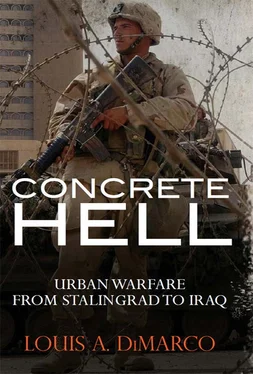The 1BCT did not have the combat power to seize a city the size of Ramadi quickly in a single operation. Additionally, the BCT’s guidance was to not conduct a conventional urban attack as had been undertaken in Fallujah. Therefore the BCT determined to seize control of Ramadi using the technique developed by the 3rd Armored Cavalry Regiment a year previously in the city of Tal Afar. This technique was a phased operation built around several premises. First, the BCT had to disregard the forward operating base (FOB) approach to urban warfare. This approach, conceptually developed before the invasion of Iraq, envisioned basing combat units outside of the urban area and then projecting combat power into the city to achieve very specific effects. It was designed to minimize the amount of urban combat, and the amount of contact between military forces and the civilian population. The FOB approach worked when the combat units were working in support of friendly indigenous forces already inside the city, or when the city was under the control of a conventional opponent who had identifiable critical vulnerabilities that could be attacked. Neither condition existed in Tal Afar in 2005 or in Ramadi in 2006.
The approach to seizing Ramadi determined by the 1BCT was described as “clear, build, and hold.” This later became the central concept of the US surge offensive throughout Iraq in 2007–08. The first step was for US forces to clear a particular discrete subsection of the city. This was accomplished by establishing a combat outpost in the midst of that section of the city. The US forces, supported by the Iraqi army, would then hold that section of the city against counterattacks or infiltration by AQI. As the US forces cleared and held their assigned part of the city, they and their Iraqi partners would simultaneously build institutions and infrastructure in that subsection to win the loyalty of that portion of the city’s population. In this manner, sections of the city would gradually and systematically be brought under US control and then turned over to the government of Iraq and the Iraqi army. This operational technique was time consuming, but it allowed the attacking force to ensure dominant combat power at the point of attack and thereby minimize friendly casualties. The 1BCT determined to conduct one major operation a week to keep the initiative and maintain the momentum of the attack. The pace of the operation was also designed to keep AQI reacting to events, off-balance, and surprised. The goal of the clear, hold, and build strategy was to systematically eliminate AQI and nationalist insurgency dominance of the city and replace their presence with the dominance of Iraqi army and police forces.
A Slow but Systematic Battle
The first step in the 1BCT plan was to isolate the city from external support. The concept was not to stop traffic from entering the city, but rather to control traffic coming into the city. This was done by establishing outposts on the major avenues into the city central from the north, west, and east. The SURCs interdicted any waterborne traffic. These operations were to prevent the free flow of supplies and reinforcements into the city and thus prevent large-scale reinforcement of the approximately 5,000 combatants operating in the city. To this end TF 1/35 Armor was assigned the mission of controlling access from the west into the city; TF 1/6 Infantry was given the mission of controlling access to the city from the north; and 1/506 Infantry was assigned to control entry from the east. The 3/8 Marines, inside Ramadi, would continue the mission of securing the government center.
Controlling access into the city was a difficult mission just because of the size of the city and its suburbs and the huge volume of people and goods moving in and out. An example of the size of this task was the area of TF 1/35 Armor, covering the western approaches to the city. The battalion had a total of four combined arms teams (companies) to accomplish its mission. With these small units, it was tasked with securing the suburb of Tameen on the west bank of the Habbaniyah Canal and its population of 40,000, as well as the 20,000 people living north of Camp Ramadi in the Zangora district. To accomplish this mission the TF used a team consisting of a tank platoon, scout platoon, and mortar platoon to operate static vehicle observation posts securing routes Mobile and Michigan in their sector as well as the rural Zangora region north of Camp Ramadi. Two teams — one of mechanized infantry and one tank team — operated in central Tameen. These two units conducted a combination of mounted and dismounted patrols and static mounted observation posts to control the area. They were subject to daily sniping, IED attacks, VBEID attacks, and small-arms fire. Over a six-month period (TF 1/35 redeployed in October 2006), the infantry team took 25 percent casualties during operations in Tameen. However, the teams greatly restricted the ability of AQI to transit and influence their area of operations. Because of the size of the area, the fact that it was a supporting effort to the main operations in the central city, and the low density of troops available, a permanent COP in Tameen was not established until October 2006. Tameen was not completely pacified before the TF redeployed.
On June 7, 2006, a coalition airstrike near Baghdad killed Abu Musab al-Zarqawi, the leader of AQI. The 1BCT determined to take advantage of the degradation of the AQI leadership to accelerate the start of operations into the center of Ramadi. On June 14, the BCT ordered TF 1/37 Armor to move across the Habbaniyah Canal and establish COP Falcon in the southwest section of the central city. The was the beginning of the systematic clearing of Ramadi. The operation began with the night infiltration of a US Navy SEAL team into preselected buildings that would be the center of the COP. Seven buildings in total were occupied. Each family was paid $2,500 a month by the US military for the use of the building. The SEALs entered the building, evicted the Iraqis living there, and secured it. As the SEALs secured the building, a route clearance team moved rapidly from Camp Ramadi down the route to the COP, clearing IEDs as it moved. It was closely followed by a tank team. The tank team then linked up with the SEALs and relieved them of responsibility for the COP. The SEAL team then moved out several hundred yards from the COP and set up sniping positions along likely avenues that AQI would use to counterattack against the COP. Meanwhile combat engineers, escorted by mechanized infantry and tanks, moved to the COP with flatbed trucks carrying concrete barriers, generators, building material, sandbags and concertina wire. Power was established, antennae put up, and towers and heavy weapons installed. Within hours the COP was secure, and over the subsequent days the engineers continued to improve the position with more barriers, wire, and other defensive support. Two weeks later the COP was complete with over a hundred sections of concrete wall and 50,000 sandbags. It was invulnerable to machine-gun fire.
An entire US company made COP Falcon its permanent home. In addition, an IA company moved into the COP with the Americans. Eventually the SEALs set up a forward base at the COP. The COP was the base for CF operations in southwestern Ramadi, the purposes of which were to protect the civil population from AQI and its supporters, and to establish control of the area by the government. The COP also became the base for patrolling and intelligence gathering. Both conventional and special operations snipers also operated out from the COP. From the COP the BCT could exert effective control several hundred yards in all directions in the city. In normal operations a span of control of a few hundred yards is not tactically decisive, however, in urban warfare, and in particular in a densely populated city like Ramadi, controlling several hundred yards of terrain brought thousands of civilians and dozens of businesses under the shadow of the BCT’s security. It also subjected all traffic transiting the COP’s area of influence to COP stop and search capability. Thus, the COP Falcon became the first crack in AQI’s control of the Ramadi population.
Читать дальше












